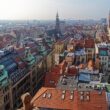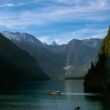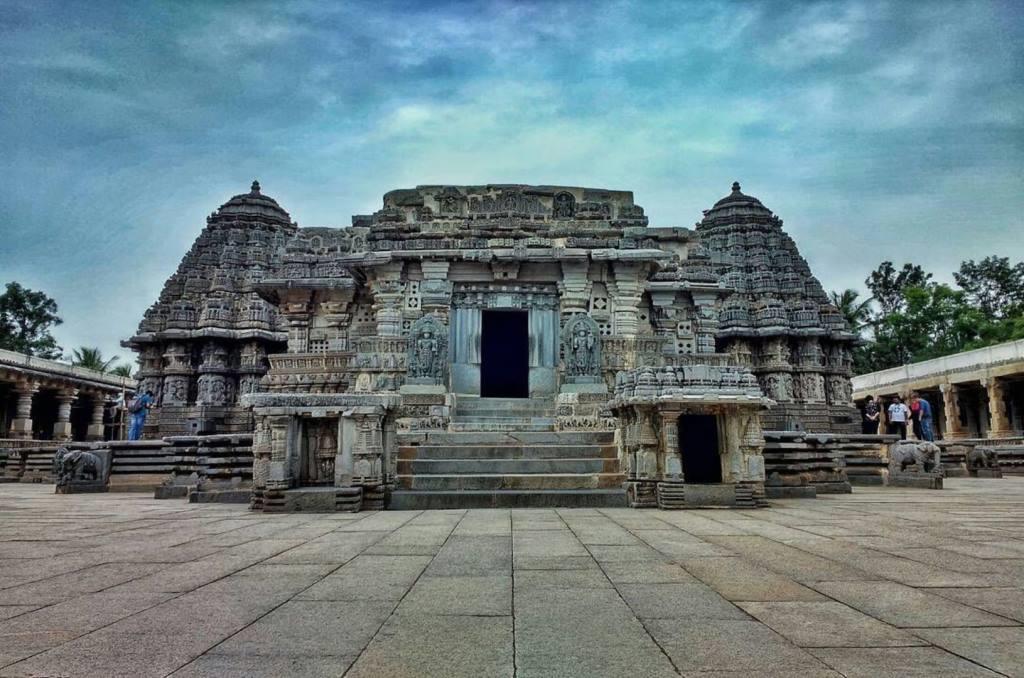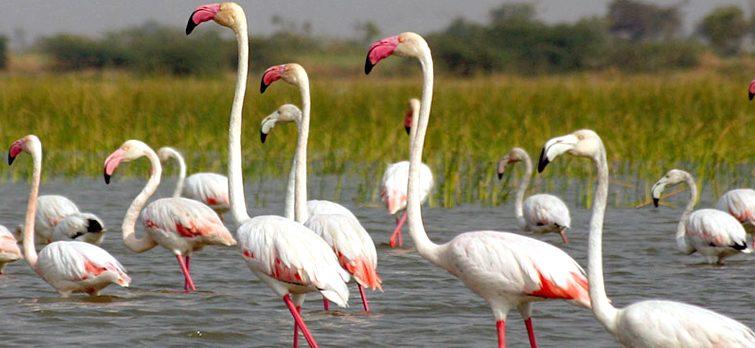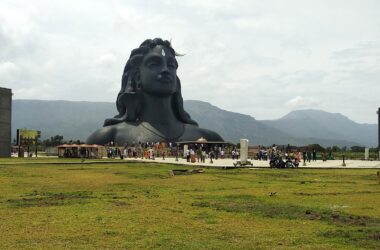Hassan, an integral part of the erstwhile Hoysala kingdom, is perfect for exploration with its pleasant climate and picturesque scenery. The undulating plains gradually slope towards the Western Ghats of Hassan. Present-day Belur and Halebidu in the district were the capital of the Hoysala Empire, and are home to exquisite architecture and sculptures.
Other lesser-known attractions like Hasanamba Temple, Mosale Temple, Saptamatrika, the sinking church at Shettihalli, the star-shaped fort at Manjarabad, and the Bisale Ghat in the district make it a heritage site. The district which is one of the more off-beat destinations in Karnataka is inviting travelers to escape in a calm, serene, and pristine environment. This is one of those places not to be rushed and is best savored over time, so find yourself a comfortable abode in the city.
Tourist Attractions in Hassan
Chennakeshava Temple, Belur

hassan karnataka
Belur, situated on the banks of the Yagachi River, was one of the capitals of the Hoysala Empire. Famous for its splendid Chennakeshava temple (also known as Vijaya Narayana Temple), built by the Hoysala king Vishnuvardhana in 1116 AD to celebrate his victory over the Cholas, it is believed to have been built by master craftsmen – Dasoja and Chavan, a father. and was created by the son duo.
It is believed that it took about 103 years to build this star-shaped temple. At the entrance are a huge gopura and a magnificent idol of Garuda, the carrier of Lord Vishnu, palms touching in sacred tribute. The temple stands on a platform and has exquisite artifacts depicting the Puranas and epics on its outer walls, all carved to perfection. Another interesting piece of sculpture in the temple complex is the Gravity Pillar, carved out of a single rock, the structure standing on its own weight. Equally impressive are the temples of Kappe Chennigaraya, Soumyanayaki, Andal, and other Vaishnava manifestations, which surround the main temple.
The inside workmanship is much finer than the outside. The sanctum sanctorum has a magnificent 3.7 m tall image of Lord Vijay Narayan in black stone. The sanctum sanctorum has a stellar shape and its zigzag walls make the images of the 24 forms of Lord Vishnu stand out throughout the day due to the changing direction of light. The bracket figures of the Madanikas (celestial nymphs) are elaborately done with water droplets chiseled to perfection.
Hoysaleswara Temple, Halebeedu

hassan karnataka
The ancient capital of the Hoysalas, Halebidu (formerly known as Dwarasamudra) is just 17 km from Belur. The Hoysala dynasty ruled most parts of South India for nearly 200 years, and during this time they built magnificent temples; Both Hindu and Jain. In the 14th century, the armies of Alauddin Khilji and Muhammad Tughlaq defeated the Hoysalas and raided their empire. It is recorded that huge money and money was looted. The city never recovered and fell into neglect. In fact, Halebidu means “Old House / Old Ruins”. However, few temples survived this devastation like the one in Halebidu and when you visit them today, you will be mesmerized by the expressions carved in stone.
The Hoysaleshwara Temple, built on a star-shaped base on the lawn, is an architectural marvel. This twin temple is probably the largest Shiva temple built by the Hoysalas. Its base has 8 rows of friezes carved with scrolls of elephants, lions, horses, and flowers. Its walls are adorned with intricately carved friezes depicting the lives of Hindu gods, sages, stylized animals, birds, and Hoysala kings. Images from epics such as Ramayana, Mahabharata, and Bhagavad Gita adorn the outer walls with highly ornate temple doors.
It is believed that no other temple in the country holds the Indian epics as splendidly as the Hoysaleshwara Temple. The temple complex also houses a museum that houses the sculptures, sculptures, and sculptures excavated in and around Halebidu by the Archaeological Department.
Shravanabelagola

hassan karnataka
Shravanabelagola is home to an 18-meter high statue of Lord Gomateshwara, which is considered to be one of the tallest free-standing monolithic statues in the world. Built-in 981 AD by Chamundaraya, a Ganga warrior, the statue is carved out of a single block of granite and looms over the picturesque Vindhyagiri Hill. It is visible from a distance of 30 km and has about 700 steps carved into the rock face. It is astonishing to see the grace and chivalry etched on a sculpture of such a scale. The idol actually depicts the idea of great power devoid of anger and wrath. This huge monolithic idol of Lord Gomateshwara will surely leave you in awe. The surrounding enclosures have pictures of all the Jain Tirthankaras.
Perhaps the most exciting act of worship can be seen here during the famous Maha Mastakabhishek ceremony. Every 12 years, Jain pilgrims gather here to participate in the colorful Maha Mastakabhisheka (head-anointing ceremony) of the Lord. From a specially constructed scaffolding, priests and devotees place hundreds of pots of curd, milk, honey, vermilion, coconut water, turmeric paste, and even gold and precious gems on the head of the statue. The entire structure is drenched in different colors which is a sight to behold. The most recent Maha Mastakabhishek was held in 2018.
Parshwanatha Swamy Temple, Basadi Halli

hassan karnataka
Halebidu is believed to have had several Jain settlements, but today only three remain. The Parsvanatha Swamy Temple, located near the Hoysaleshwara Temple, is the most beautiful of the three Basadis. There are rich carvings and 12 pillars holding the dome of the temple. The 14 feet figure of Lord Parshvanath is made of black stone, with a seven-headed serpent on top of its head.
Kedareshwara Temple

hassan karnataka
Situated near Hoysaleshwara Temple, this temple is a gem of Indian architecture. It is said that a tree took root in the tower and destroyed it. The outer walls, minarets, and gates are decorated with magnificent carvings. The base of the temple, which stands on a high plinth, has a large number of friezes depicting elephants, horses, lions, mythical animals, swans, and stories from epics.
Veeranarayana Temple, Belavadi

hassan karnataka
Belavadi is home to the famous Veeranarayana Temple which is the largest Trikutachal (three shrines) temple built by the Hoysalas. Here the idols of Veeranarayana, Venugopal, and Yoga Narasimha are situated in the same temple complex. The idol of Venugopal is considered to be one of the most beautiful idols. It has the most pillars of any Hoysala temple, about 152 in total; Each of them is a unique piece of craftsmanship.
Lakshminarasimha Temple, Javagal

hassan karnataka
One of the lesser-known gems of Hoysala architecture, Laxminarasimha Temple, is a Vaishnava temple dedicated to Lord Narasimha (a half-man half-lion avatar of Lord Vishnu) with his consort, Goddess Lakshmi. The other two temples of this Trikutachal temple are those of Lord Vishnu and Lord Venugopal (playing the flute).
The outer walls here are quite attractive due to the intricately carved sculptures. Dashavatara (10 avatars of Lord Vishnu) is depicted exquisitely here.
Hasanamba Temple

hassan karnataka
Inside the temple complex, there are three temples dedicated to Hasanamba, Darbar Ganapati, and Siddheshwar. Although the goddess is known as Hasanamba, she is not a goddess but a trinity. Here all the three Shakti-swarupini are seated together. Another interesting feature is that the Hasanamba temple is opened only once a year (for a few days) during the Diwali celebrations.
There is a unique tradition here that while closing the doors, the deity is decorated with flowers and a ghee lamp is lit. When the doors are opened again the next year, thick smoke fills the sanctum sanctorum and the lamp is still burning. Even the flowers retain their freshness throughout the year.
Mahalakshmi Temple, Doddagadavahalli

hassan karnataka
The temple dedicated to Goddess Mahalakshmi at Doddagadavalli is credited with several firsts in Hoysala architecture. It is believed to be the first temple built in the signature Hoysala style. It is also the only Hoysala temple where the idol of Goddess Mahalakshmi is installed, in which both Vaishnava and Shaiva worship is performed.
Mosale

hassan karnataka
Mosale is a small village in Hassan with two breathtaking Hoysala temples dedicated to Lord Nageshwar and Lord Chennakeshava. Built around the 12th century, it is made of soapstone and is very similar to each other, standing a few feet apart.
In front of the Nageshwar temple is a beautiful Nandi idol and a linga while the Chennakeshava temple has a beautiful idol of Lord Vishnu and Prabhavali is decorated with his various incarnations.
Gorur

hassan karnataka
Gorur, which houses several Hoysala temples, is also home to one of the largest reservoirs in Karnataka – the Gorur Dam. At the entrance of Gorur, a temple dedicated to Lord Paravasudeva can be seen. Another temple dedicated to Lord Yoganarsingh has been built on the banks of the Hemavati river close to the dam. Built-in 1979, the Hemavati Dam covers a catchment area of 2,810 sq km. The dam has become a popular picnic spot due to the spectacular views and the lush green lawns right next to it.
Manjarabad Fort

hassan karnataka
Manjarabad Fort, located in Sakleshpur, is situated on top of a hill, which is about 988 meters above ground level. This fort was built by Tipu Sultan in 1792 for the purpose of driving away from the intruders from Mangalore and Madikeri. The fort is built in a star-shaped design with eight angular tips extending in eight directions and a plus-shaped well in the center. A short climb to the top gives a beautiful view of the Western Ghats.
Shettihalli Rosary Church

hassan karnataka
Built by French missionaries in India during the 1860s, this church is a fine example of the Gothic style of architecture. After the construction of the Gorur Dam, the area around the church became deserted due to monsoon floods. If you visit the place during the peak monsoon season, only a third of the chapel will be visible. The view of the submerged church is very beautiful during the monsoon. A new church has been built on higher ground nearby with the buildings of this church.
Bisle Ghat

hassan karnataka
This is a vast 40 hectares reserved forest area in Sakleshpur. Surrounded by the Western Ghats, Bisale Ghat is near the border of Hassan, Kodagu, and Dakshina Kannada districts. It has a beautiful stretch with dense forests, mountain ranges, and trekking trails. The view from Bisle Ghat’s viewpoint is truly spectacular. There are many hills like Pushpagiri, Kumara Betta, Yenikallu which are ideal for trekking. Various species of flora and fauna are found here including teak, rosewood, Indian copal, tulip, and Malabar kino as well as elephant, bison, sambar, wild boar, and other wild animals.
Similar Article
Frequently Asked Questions About Hassan
Hassan Weather (Link)
Q. Why is Hassan famous?
A – Hassan is mainly famous for its old temples like Lakshmi Narasimha Temple, Kedareshwara Temple, and Hoysala Temples. They represent the history and cultures of Hassan very well. The district was named after the goddess Hasanamba and traces of the Hoysala kingdom can be traced back to Hasan.
Q. What is another name for Hassan?
A – Depending on language and region, spelling variations include Hasan, Hassen, Hasson, Hassin, Hassine, Hacen, Hasen, Hasin, Hassa, Hess, Cassin, Chazan, Chasson, Chason, Khassan, Khasan, Chessar, Casan, Casen, Hasso, Lassana, Alassane, Lacen, Lasanah, Assan, Asan, or Haasan (Haasaan, Hasaan, Hassaan).
Q. Who ruled Hassan?
A – The Hoysala Empire ruled the city for a long time and their influence can be seen in the art and inscriptions on various monuments. It is a place in India that is covered with many centuries-old temples and monuments and hence extremely popular among tourists, pilgrims, and history buffs.
Q. Who is Banwara Raja?
A – The Battle of Banwar was a land battle fought in the year 1682 between the Maratha Empire and the Kingdom of Mysore. The Mysore army under King Chikka Devaraja defeated the Maratha army under Sambhaji and their allies, causing him to temporarily retreat.
Q. Who is Hassan in Islam?
A – Posture. Hasan, full Hasan ibn Ali ibn Abi Alib, (born 624, Arab—died 670, Medina), grandson of the Prophet Muhammad (founder of Islam), eldest son of Muhammad’s daughter Fatima.
Q. Is Hassan a city or a town?
A – Hassan is a city and district headquarters in Hassan district in the Indian state of Karnataka. The city is situated at an altitude of 980 meters (3,220 ft) above sea level. It is named after Hasanamba Temple. The urban population in 2011 was 133,436.
Q. How many hoblis are there in Hassan district?
A – The total area of Hassan district is 6826.15 square kilometers. The district comprises 8 taluks, 38 hoblis, and 2369 villages.
Q. How many villages are there in the Hassan district?
A – Hassan has a population of 3,96,166. There are 98,290 houses in the sub-district. There are about 360 villages in Hassan block, which you can see from the list of villages below.
Q. What is Hassan’s PIN code?
A – Hassan PIN code/Zipcodes
573201
573202
573212
573220
Q. How is the road from Bangalore to Hassan?
A – The journey between Bangalore and Hassan, which used to take almost five hours a year ago, has just become smoother and shorter. Now, the 185-km distance between Hassan and Bangalore on National Highway 48 can be covered in less than three hours after the road was upgraded to a four-lane highway.
Q. Can we see the Arabian Sea from Manjarabad Fort?
A – As the fort is situated on a hill at an altitude of 988 meters (3,241 ft), it gives a clear and commanding view of the surroundings. The Arabian Sea can also be seen from the fort on a clear day.
Q. Why was Manjarabad Fort built?
A – Manjarabad Fort was built in 1792 when Tipu Sultan wanted to guard the way to Mangalore and Coorg. It is one of the few forts built by Tipu where there was none earlier.
Q. How many steps are there in Manjarabad fort?
A – About 7 km from Sakleshpur, on NH 48 towards Mangalore, climbing a 200 mt mud road on the left leads to a staircase to the fort. A steep ascent up the staircase of about 250 steps brings the visitor to the ornate main gate.
Q. How many steps are there in Manjarabad Fort?
A – About 7 km from Sakleshpur, on NH 48 towards Mangalore, a staircase leads to the fort by climbing a 200 m mud road on the left. A steep climb up the steps of about 250 steps brings the visitor to the ornate main gate.
Q. Is Sakleshpur worth visiting?
A – This quaint hill station offers a pleasant experience for naturalists and has breathtaking trails for trekking enthusiasts. Some of the most popular places to visit in and around Sakleshpur include majestic temples, monumental forts, enchanting waterfalls, spectacular hikes, and biodiversity hotspots.
Q. What is Shravanabelagola famous for?
A – One of the most visited Jain pilgrimage sites in South India, Shravanabelagola is a popular weekend getaway from Bengaluru. It is famous for the 57 feet tall statue of Bahubali, the world’s tallest monolithic stone statue carved from a single granite block.
Q. Which god is in Shravanabelagola?
A – In the town of Shravanabelagola, there is a huge rock-cut idol of Lord Gommateshwara Sri Bahubali.
Q. Who is the real Bahubali?
A – The real Bahubali, a respected figure among Jains, is the son of the first Tirthankara (spiritual teacher), Rishabhanatha. Their exact timeline is impossible to verify because, in Jainism, you can replace ‘millions of years ago with ‘decades-years ago’ – and still be less.
Q. How is the road from Bangalore to shravanabelagola?
A – Route1: Bangalore – Kunigal – Yadiyur – Hirisave – Shravnabelagola, clocking 2.5 hours and 143 km via NH 75.
Route 2: Bangalore – Magadi – Kunigal – Hirisave – Shravanabelagola, via SH 94 and NH 75. The distance is 172 km and it takes approximately 3 hours 15 minutes to reach Shravanabelagola without any detour.
Q. What is the old name of Shravanabelagola?
A - Gomateshwara (Bahubali) Temple – Karnataka. About 158 km from Bengaluru and 83 km from Mysore, there is a town located in Karnataka known as the city of ponds and temples – Shravanabelagola.
Q. How old is the idol of Shravanabelagola?
A – Scout to be 1000 years old, the 57 feet tall statue of Gommateshwara Bahubali at Shravanabelagola is believed to be the tallest monolithic sculpture in the world, carved out of single granite rock and standing on top of a hill.
Q. Who built the Shravanabelagola Temple?
A – Shravanabelagola is home to an 18-meter high statue of Lord Gomateshwara; Considered one of the tallest free-standing monolithic sculptures in the world. Built by Chamundaraya, a Ganga warrior in 981 AD, it is built on a single block of granite and looms on the top of Vindhyagiri hill.
Q. What is the specialty of Shravanabelagola?
A – The most famous of such abhishekas is the consecration of the Bahubali Gommateshwara statue located at Shravanabelagola. It is an important Jain festival held once every 12 years. It is an integral part of the ancient and holistic Jain tradition

